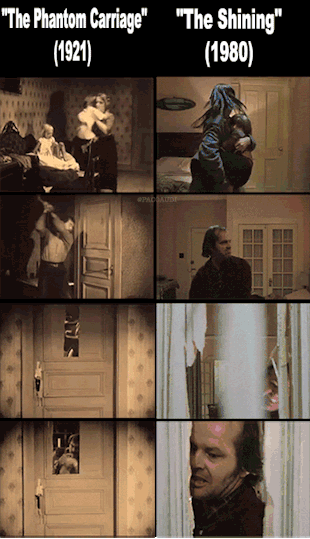
![]()
Have you ever completely forgotten that you’ve seen a film before until you’re in the middle of watching it? I ran across a couple posts recently that compared Stanely Kubrick’s masterful horror landmark The Shining to a 1920s Swedish film named The Phantom Carriage. There was one .gif in particular that mirrored the two works’ infamous axe scenes that really caught my attention while scrolling through Tumblr posts. I made a point to bump the Criterion-restored version of The Phantom Carriage to the top of my Hulu queue only to discover about five minutes into the film that I had seen it once before, years & years ago, and already really enjoyed it.

A silent film that combines horror & dramatic tragedy, The Phantom Carriage tells a similar story as works like It’s a Wonderful Life & A Christmas Carol with an intense focus on the supernatural aspect of that framework. In the movie’s mythology whoever dies last on the last day of the year must drive Death’s carriage for a full year. Each day feels like 100 years as the titular phantom carriage’s driver makes their rounds like a mail room clerk, collecting souls from the recently deceased on Death’s behalf. The horse & carriage are always the same, but the driver is different each year, almost like a morbid version of the Tim Allen comedy The Santa Clause.
On this particular New Year’s Eve the newest phantom carriage driver-elect is one David Holm, a boozy sinner who’s spent most of his life abusing anyone who dares to love him. Before David’s (literally) given the reins, however, he’s forced to take a remorseful journey through his own past, bearing witness to each horrifically shitty thing he’s done to his fellow man. David is forced by Death’s previous servant to watch as his past self abandons his family in favor of booze, shames the charitable for caring about his well-being, and intentionally tries to spread consumption among the innocent out of pure malice. He can barely stand to watch himself act like such a destructive ass & that discomfort is a large portion of his punishment as Death’s new servant.
Outside the obvious homage in the axe scene pictured above, there isn’t much to The Phantom Carriage‘s connection to The Shining except on a very basic thematic level. The Phantom Carriage is a ghost story about alcoholism & familial abuse in which the temporary caretaker of a supernatural, cursed establishment is driven to cruelty, so yeah, it does telegraph a lot of the basic structure of where Kubrick would take his Steven King adaptation over 50 years later. However, Kubrick is far from the first director who comes to mind while watching The Phantom Carriage, which is likely why I didn’t remember seeing the film before when prompted by those social media posts.
It’s Ingmar Bergman who pulled the most readily recognizable influence from the silent classic. As soon as Death’s servant arrives in the iconic hooded robe & sickle get-up, Bergman’s version of Death in The Seventh Seal immediately comes to mind. Before I even read this film’s Wikipedia page I could’ve told you Bergman watched The Phantom Carriage religiously and, indeed, the director claimed to have viewed it at least once a year. It’s possible to argue that The Shining would’ve been a very different work without The Phantom Carriage‘s influence, but what’s an even more immense question is just how different Bergman’s entire aesthetic would be without the seminal work. It’s crazy to think of the massive influence Bergman’s image of Death has had across pop culture, from The Last Action Hero to The Independent to Bill & Ted’s Bogus Journey (naming a few personal favorites), and that its seed was actually planted in the silent era.
The Phantom Carriage is well worth a watch even outside its massive influence on the likes of Kubrick & Bergman. The film was noteworthy in its time for innovations in its ghostly camera trickery and its flashback-within-a-flashback narrative structure. Those aspects still feel strikingly anachronistic & forward-thinking today, especially the gnarly phantom imagery, but you don’t have to be a film historian to appreciate what’s essentially a timeless story of brutally cold selfishness & heartbreaking remorse. I also like the movie’s gimmick of trying to make a non-Halloween holiday spooky (the film was set, plotted around, and released on New Year’s Eve), something schlock horror would do with Valentine’s Day, Christmas, and whatever else for decades to come. It’s a shame that at one point I forgot I watched The Phantom Carriage in the first place. It’s a great slice of horrific silent cinema & innovative filmmaking history.
-Brandon Ledet
Pingback: Destiny (1921) |
Pingback: The Golem: How He Came Into the World (1920) |
Pingback: Midnight Faces (1926) | Swampflix
Pingback: Halloween Report 2015: Best of the Swampflix Horror Tag | Swampflix
Who composed the exquisite music for The Phantom Carriage? Many thanks.
LikeLike
Pingback: The Phantom Chariot (1921) and Burglars (1930) | CarensClassicCinema